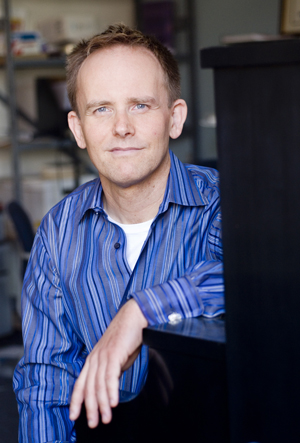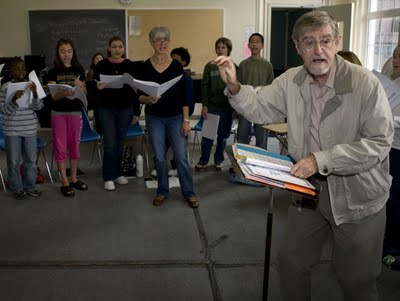Conspirare Celebrates Thoughtful Christmas in Texas

I must confess that I have a soft spot for thematic concerts; for while I admire virtuosity and outstanding musicality as much as anyone, I also want to see that performers have taken the trouble to do their homework, and that they have considered the intellectual implications of what they are presenting to the public. Choral conductor Craig Hella Johnson has practically written the book on how this should be done and his Christmas at the Carillon program, 2009 edition, featuring the choral group known as Conspirare, was just the latest chapter.
Before I talk about the performance I heard, some clarification may be useful. This concert was not “at the Carillon”, but at the Long Centre for the Performing Arts - seating 2400 - in downtown Austin, Texas. The Carillon is a small chapel - seating approximately 150 - in west Austin where Conspirare regularly presents some of its Christmas concerts.
Interweaving of Familiar and Unfamiliar Constructs Message
If I tell you that this concert included some familiar Christmas carols, I would be giving you information that is almost beside the point. What made this concert memorable was not so much the familiar but the unfamiliar music presented, and even more importantly, the way in which music and text were woven together over the course of the evening.

Craig Hella Johnson (photo: right) had an overarching concept for this concert. It was basically quite simple in its message: souls losing their way, lost in darkness, finding the light and achieving happiness. This simple message, however, was carefully constructed and delivered in the most non-confrontational and non-denominational way possible; he let the words and the music speak for themselves.
While there was a certain low-key sameness about the pieces chosen, ennui was avoided by mixing musical and textual genres. The work of ‘classical’ composers like Stephen Paulus, Handel and John Rutter was mixed with pop music by Mary Chapin Carpenter and Stevie Wonder, Broadway music by Lerner and Loewe and gospel music - ancient and modern. Patrice Pike, a popular Texas rock star, was a featured guest artist on the program.
What I liked most about the pop music, was the way in which Johnson stripped these songs of their high decibels and ubiquitous guitars and percussion, and so revealed the beauty and meaning of the words and the originality of the melodies.
In all this music, the twenty-three members of Conspirare – from the Latin “con” and “spirare” rendered as “to breathe together” – demonstrated their extraordinary skills as both soloists and choral artists.
Speaking of Light...and Togetherness
Johnson had obviously been preparing this concert for a long time and had considered every detail. Well, almost every detail. It was a fine idea to present the concert not only without intermission, but also without any breaks for applause until the mid-point. It was also a fine idea to provide the audience with the complete text for every piece performed – that’s twenty pages of text! Much of the text is beautiful and thoughtful poetry that must be seen and not just heard to be appreciated, but somebody dropped the ball and in so doing undermined much of what Craig Hella Johnson had so carefully planned: the house lights were turned off for the entire concert! There was no way members of the audience could read the program.
There is another element that unfortunately limited the impact of Johnson’s vision on this occasion. This was an intimate program, featuring mostly quiet and thoughtful music. In the small but resonant confines of the Carillon chapel, my guess is that the audience would have felt enveloped by the music and the whole experience. The Long Center, on the other hand, is dry as a bone and its very nature is to distance performers and audience from each other.
Naturally, performers always want to reach larger audiences, but sometimes enlarging the space diminishes the experience. Christmas at the Carillon might work in a space as large as the Long Center, but Johnson will have to make some adjustments. Perhaps more amplification and perhaps more instrumentalists would help. In the larger space the meditative quality of text and music can be easily lost.
I also felt that at times the concert came perilously close to new age blandness. Again, this was largely a function of the large hall. In this space Johnson might consider adding some more rousing pieces, spoken readings and a touch of humor now and again.
A case in point: Johnson chose to end the concert with a dream sequence version of “I could have danced all night” from Lerner and Loewe’s My Fair Lady. Bits of this familiar song were interwoven with Christmas words and music and elements of what had come before in the concert. It seemed to me, however, that what was needed was more like the original version of “I could have danced all night” with its ecstatic celebration of love and joy.
Johnson ended this concert with a sort of bittersweet smile when a joyous outburst might have sent the audience away feeling rejuvenated.
Conspirare CD Nominated for Grammy Award
Being the thoughtful and creative man that he is, I am sure Craig Hella Johnson has already begun processing the results of this year’s Christmas at the Carillon and that he will soon begin building an even deeper and more multi-faceted program for 2010.
Conspirare is already one of the finest and innovative choral ensembles in the country and with Johnson at the helm, its reputation can only continue to grow. Anyone wanting to know what the excitement is about, should investigate Conspirare’s most recent CD, Company of Voices: Conspirare in Concert (Harmonia Mundi HMU 907534), which was just nominated for a Grammy in the category “Best Classical Crossover Album”. This concert is also available on DVD (Harmonia Mundi HMD 9907535).
Paul E. Robinson is the author of Herbert von Karajan: the Maestro as Superstar, and Sir Georg Solti: His Life and Music, both available at Amazon.com.
Labels: Chttp://www.austinchronicle.com/binary/1048/arts_feature1-4.jpghristmas at the Carillon, classical music blog, Conspirare Symphonic Choir, Craig Hella Johnson, Long Center




